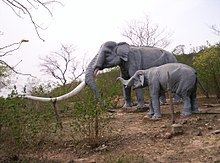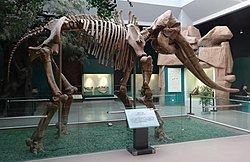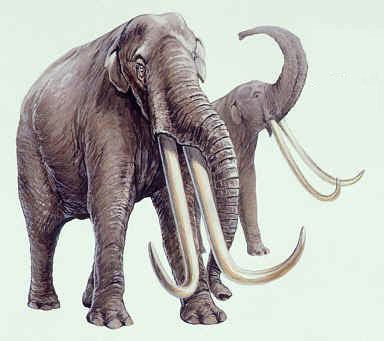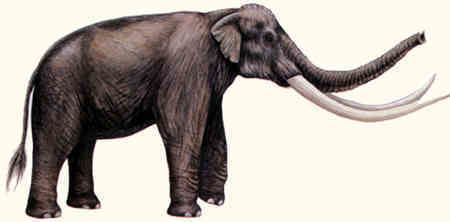Scientific name Stegodon Phylum Chordata | Family †Stegodontidae Rank Genus Higher classification Stegodontidae | |
Similar Gomphotherium, Proboscidea, Mammal, Stegodon trigonocephalus, Flores man | ||
Stegodon (meaning "roofed tooth" from the Greek words στέγειν stegein 'to cover' and ὀδούς odous 'tooth') is a genus of the extinct subfamily Stegodontinae of the order Proboscidea. It was assigned to the family Elephantidae (Abel, 1919), but has also been placed in Stegodontidae (R. L. Carroll, 1988). Stegodonts were present from 11.6 mya to late Pleistocene, with unconfirmed records of regional survival until 4,100 years ago. Fossils are found in Asian and African strata dating from the late Miocene. They lived in large parts of Asia, East and Central Africa and North America during the Pleistocene.
Contents
- Proboscidea evolution of elephants pliocene and pleistocene stegodon
- Size
- Dwarfism
- Taxonomy
- Phylogeny
- References

Proboscidea evolution of elephants pliocene and pleistocene stegodon
Size

Stegodon was one of the largest proboscideans, along with more derived genera. S. zdansky is known from an old male (50+) from the Yellow River that is 3.87 metres (12.7 ft) tall and weighed approximately 12.7 tonnes (12.5 long tons; 14.0 short tons). It had a humerus 1.21 metres (4.0 ft) long, a femur 1.46 metres (4.8 ft) long, and a pelvis 2 metres (6.6 ft) wide.
Dwarfism

A dwarf population survived until 12,000 years ago on the island of Flores, Indonesia. A review of 130 papers written about 180 different sites with proboscidean remains in southern China revealed Stegodon to have been more common than Asian elephants; the papers gave many recent radiocarbon dates, the youngest being 2,150 BCE (4,100 BP). However, Turvey et al. (2013) reported that one of the faunal assemblages including supposed fossils of Holocene Stegodon (from Gulin, Sichuan Province) is actually late Pleistocene in age; other supposed fossils of Holocene stegodonts were lost and their age cannot be verified. The authors concluded that the latest confirmed occurrences of Stegodon from China are from late Pleistocene, and that its Holocene survival cannot be substantiated. The name Stegodon is derived from the Greek words στεγειν stegein ('to cover') and οδον odοn ('tooth') because of the distinctive ridges on the animal's molars.

Stegodon florensis insularis is an extinct subspecies of Stegodon endemic to the island of Flores, Indonesia, and an example of insular dwarfism. The direct ancestor of S. florensis insularis is a larger-bodied S. florensis florensis, from Early Pleistocene and early Middle Pleistocene sites on Flores . Remains of S. florensis insularis are known from the cave of Liang Bua.
Similar to modern-day elephants, stegodonts were likely good swimmers, as their fossils are frequently encountered on Asian islands (such as Sulawesi, Flores, Timor, Sumba in Indonesia; Luzon and Mindanao in the Philippines; Taiwan; and Japan), all locations not connected by land bridges with the Asian continent even during periods of low sea-level (during the cold phases of the Pleistocene). A general evolutionary trend in large mammals on islands is island dwarfing. The smallest dwarf species, S. sondaari, known from 900,000-year-old layers on the Indonesian island of Flores, had an estimated body weight of 300 kg (660 lb), smaller than a water buffalo. Another estimate gives a shoulder height of 1.2 m (3.9 ft) and a weight of 350–400 kg (770–880 lb). A medium- to large-sized stegodont, S. florensis, with a body weight of about 850 kg (1,870 lb), appeared about 850,000 years ago, and then also evolved into a dwarf form, Stegodon florensis insularis. Another estimate gives a shoulder height of 2 m (6.6 ft) and a weight of 2 t (2.0 long tons; 2.2 short tons). The latter was contemporaneous with, and hunted by, the dwarf hominin Homo floresiensis, and disappeared about 12,000 years ago. It is also believed that dwarf stegodons were the main prey of the still extant Komodo dragon before modern humans introduced their modern main prey in its range, banded pig, rusa deer and water buffalo.
Taxonomy
In the past, stegodonts were believed to be the ancestors of the true elephants and mammoths, but it is currently believed that they have no modern descendants. Stegodon may be derived from Stegolophodon, an extinct genus known from the Miocene of Asia. Stegodon is considered to be a sister group of the mammoth, as well as the elephants. Some taxonomists consider the stegodonts a subfamily of Elephantidae. Both Stegolophodon and primitive elephants were derived from the Gomphotheriidae. The most important difference between Stegodon and (other) Elephantidae can be observed in the molars. Stegodont molars consist of a series of low, roof-shaped ridges, whereas in elephants each ridge has become a high-crowned plate. Furthermore, stegodont skeletons are more robust and compact than those of elephants.
In Bardia National Park in Nepal, there is a population of Indian elephants that, possibly due to inbreeding, exhibit many Stegodon-like morphological features. Some dismiss these primitive features as recent mutations rather than atavisms.
Fossils of the small specialized stegodont Stegodon aurorae are found in the Osaka Plain, Japan, and date from approximately 2 Ma to 7 Ma. This species possibly evolved from Stegodon shinshuensis.
Phylogeny
The following cladogram shows the placement of the genus Stegodon among other proboscideans, based on hyoid characteristics:
